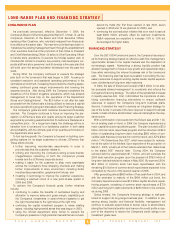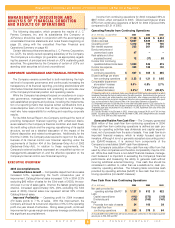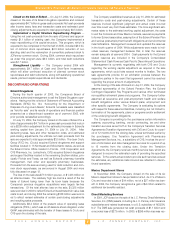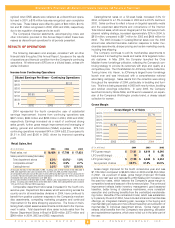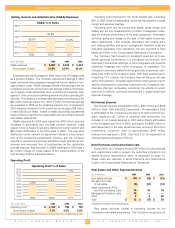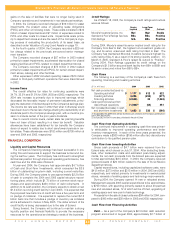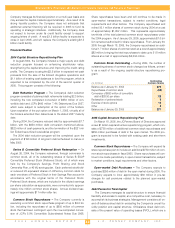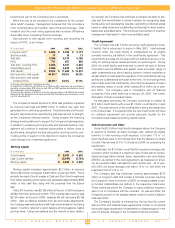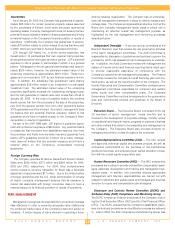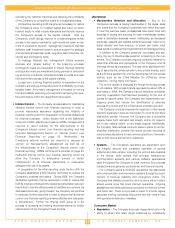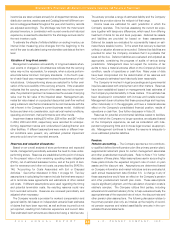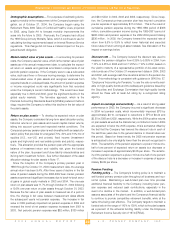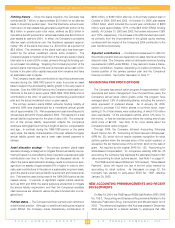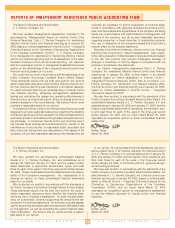JCPenney 2004 Annual Report Download - page 17
Download and view the complete annual report
Please find page 17 of the 2004 JCPenney annual report below. You can navigate through the pages in the report by either clicking on the pages listed below, or by using the keyword search tool below to find specific information within the annual report.
J.C. PENNEY COMPANY, INC.2 004 ANNUAL REPORT
Management’s Discussion and Analysis of Financial Condition and Results of Operations
15
Guarantees
As of January 29, 2005, the Company has guarantees of approx-
imately $28 million for certain personal property leases assumed
by the purchasers of Eckerd, which were previously reported as
operating leases. Currently, management does not believe that any
potential financial exposure related to these guarantees would have
amaterial impact on the Company’s financial position or results of
operations. Additionally, the Company has guarantees of approxi-
mately $10 million related to certain leases for stores that were sold
in 2003, which are recorded in Accrued Expenses and Other.
JCP, through JCP Realty, Inc., a wholly owned subsidiary, has
investments in 14 partnerships that own regional mall properties,
six as general partner and eight as limited partner. JCP’s potential
exposure to risk is greater in partnerships in which it is a general
partner. Mortgages on the six general partnerships total approxi-
mately $324 million; however, the estimated market value of the
underlying properties is approximately $610 million. These mort-
gages are non-recourse to JCP, so any financial exposure is mini-
mal. In addition, the subsidiary has guaranteed loans totaling
approximately $18 million related to an investment in a real estate
investment trust. The estimated market value of the underlying
properties significantly exceeds the outstanding mortgage loans,
and the loan guarantee to market value ratio is less than 4% as of
January 29, 2005. In the event of possible default, the creditors
would recover first from the proceeds of the sale of the properties,
next from the general partner, then from other guarantors before
JCP’s guarantee would be invoked. As a result, management does
not believe that any potential financial exposure related to this
guarantee would have a material impact on the Company’s finan-
cial position or results of operations.
As part of the 2001 DMS sale, JCP signed a guarantee agree-
ment with a maximum exposure of $20 million. Any potential claims
or losses are first recovered from established reserves, then from
the purchaser and finally from any state insurance guarantee fund
before JCP’s guarantee would be invoked. As a result, manage-
ment does not believe that any potential exposure would have a
material effect on the Company’s consolidated financial
statements.
Foreign Currency Risk
The Company operates 62 Renner Department Stores in Brazil.
Sales were $329 million, $273 million and $249 million for 2004,
2003 and 2002, respectively. For 2004, other comprehensive
income related to currency translation for Brazil was a favorable
adjustment of approximately $11 million. Due to the limited nature
of foreign operations and the U.S. dollar denomination of virtually
all import contracts, management believes that its exposure to
market risk associated with foreign currencies does not have a
material impact on its financial condition or results of operations.
RISK MANAGEMENT
Management recognizes its responsibility to proactively manage
risks effectively in order to maximize enterprise value (defined as
the combined market value of the Company’s debt and equity) to
investors. A certain degree of risk is inherent in operating a three-
channel retailing organization. The Company has an enterprise-
wide risk management framework in place to identify, measure and
manage risks. The Company’s organizational structure, both at the
Board and Company management levels, plays a critical role in
maintaining an effective overall risk management process, as
highlighted by the risk management and monitoring processes
described below:
Independent Oversight
— There are various committees at the
Board of Directors’ level that oversee the risk governance activities
of the senior management committees. The Audit Committee is
responsible for discussion of guidelines and policies to govern the
process by which risk assessment and management is undertak-
en. In addition, the Audit Committee reviews with management the
system of internal control and financial reporting that is relied upon
to provide reasonable assurance of compliance with the
Company’s operational risk management processes. The Finance
Committee reviews the Company’s overall financing plan and divi-
dend policy, as well as the liquidity position of the Company. The
Human Resources and Compensation Committee oversees senior
management committees responsible for retirement and welfare
plans, equity and other compensation plans. The Corporate
Governance Committee monitors developments in the governance
area and recommends policies and practices to the Board of
Directors.
Executive Board
— The Executive Board, comprised of the top
20 members of senior management, meets monthly and is
involved in the development of corporate strategy, monthly review
of operational and financial results, progress on planned initiatives
and other matters that relate to the leadership and management of
the Company. The Executive Board also provides direction for
managing the portfolio of risks throughout the enterprise.
Capital Appropriations Committee (CAC)
— The CAC reviews
and approves individual capital and systems projects, as well as
contractual commitments for the purchase of non-merchandise
goods and services, and ensures proper capital allocation consis-
tent with the overall capital expenditure plan.
Human Resources Committee (HRC)
— The HRC ensures that
processes are in place to provide competitive compensation pack-
ages, associate development and training and management suc-
cession plans. In addition, this committee ensures appropriate
management and fiduciary responsibilities are carried out with
respect to retirement and welfare plans and manages and provides
direction for equity and compensation plan strategies.
Disclosure and Controls Review Committee (DCRC) and
Sarbanes-Oxley (SOX) Compliance and Monitoring Group
—
The DCRC is made up of senior executives of the Company, includ-
ing the Chief Executive Officer (CEO) and the Chief Financial Officer
(CFO). The DCRC ensures that the Company’s established disclo-
sure controls and procedures and certification process are adhered
to. Late in 2004, the SOX Compliance and Monitoring Group was


